The Change Leadership Playbook
Change is inevitable — but leading change successfully is a choice.
While change management emphasizes processes, change leadership prioritizes people, culture, and mindset. It goes beyond project plans and timelines, focusing instead on inspiring, empowering, and aligning teams to achieve a shared vision, even during uncertainty.
At its core, change leadership is about driving transformational outcomes through vision, communication, and influence. Whether you’re shifting strategic priorities, introducing new technology, or redesigning your operating model, effective change leadership is the difference between frustration and sustainable success.
At Stratford People & Culture, we believe change leadership should empower people and embed resilience so change truly sticks. Drawing on our deep experience supporting organizations through growth and transition, we’ve created this resource to help you explore change leadership — what it is, why it matters, and how to build your capability to lead with confidence.
Change doesn’t have to feel overwhelming. With the right mindset, knowledge, and resources, you can lead change in a way that supports your people and strengthens your organization’s future.
Change is the new constant. The typical organization today has undertaken five major changes in the past three years — and nearly 75% expect to multiply the types of major change initiatives they will undertake in the next three years. Yet half of change initiatives fail, and only 34% are a clear success.
Gartner
Change is a constant in today’s business environment— from new technologies to shifting customer needs to global disruptions— but how you lead through it can make all the difference.
While change management focuses on plans, processes, and tools to implement change, change leadership goes a step further — it prioritizes people, culture, and mindset.
Change leadership is about creating a compelling vision for change, inspiring and empowering teams, and building the trust needed for people to adapt and succeed. Where change management answers “How do we implement this?”, change leadership asks “How do we lead people through this?”
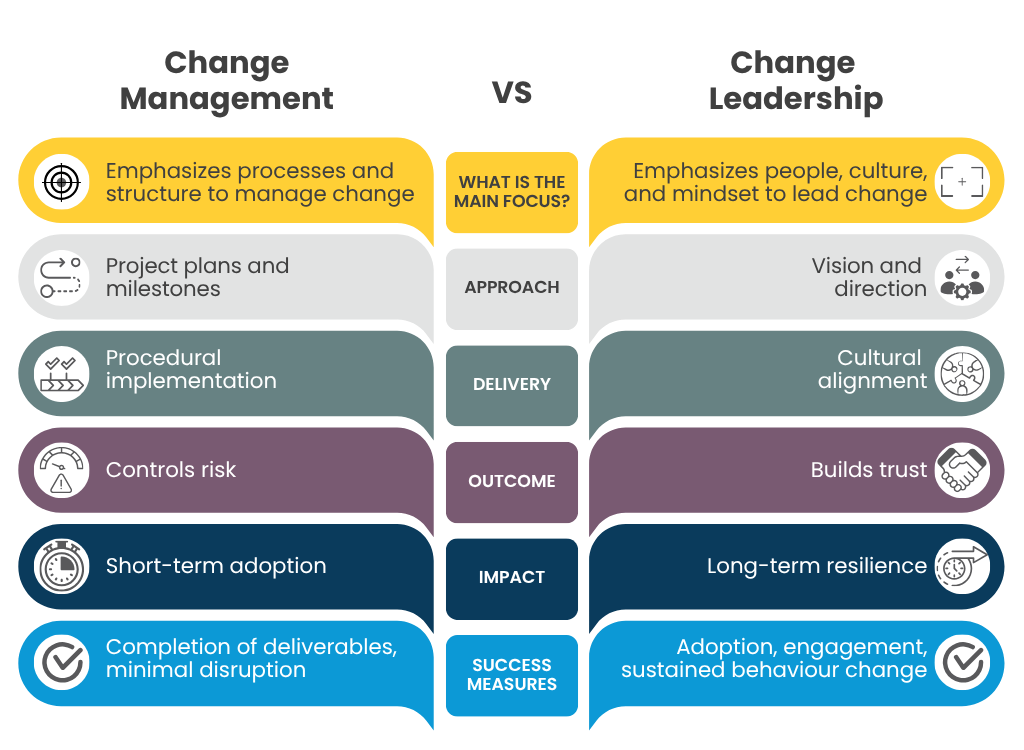
An effective change leader sets a clear direction, aligns people around purpose, and creates the conditions for resilience and growth. They foster trust and confidence so employees can move from uncertainty to opportunity, reducing the friction that so often undermines transformation efforts.
In simple terms: Change management is about execution. Change leadership is about vision, influence, and engagement.
When these two work together, organizations move through change with more confidence, less resistance, and stronger results. Leaders who understand this distinction — and build their capabilities in both — will create organizations that adapt more quickly and sustain growth.
Explore more:
Watch Lead the Change You Want to See
What does it actually take to lead change effectively?
Effective change leadership is more than a checklist. It is a mindset, a strategic lens, and a practical toolkit for inspiring people to adapt, grow, and succeed.
The most effective leaders combine a strong purpose with empathy, clarity, and accountability to build trust, confidence, and momentum. At the same time, they design systems and structures that remove barriers and reinforce new ways of working so change becomes sustainable.
Here are nine core principles to guide your approach:
.png?width=1024&name=9%20Core%20Principles%20of%20Effective%20Change%20Leadership%20(1).png)
Top 5 Habits of High Performing Leaders
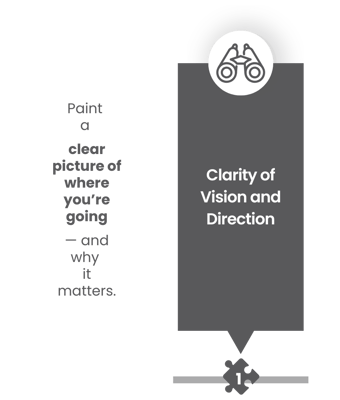
Clarity of Vision and Direction
Define what success looks like, and connect it to organizational purpose. A compelling vision is the anchor of any successful change. It describes not only what will be different, but why it matters and how it aligns with organizational purpose. Great leaders translate vision into relatable stories and examples that energize people and build confidence.
Explore more:
Engagement and Communication
Change thrives on authentic, open dialogue. Leaders must move beyond telling people what is happening to actively engaging them in shaping how change will happen. Consistent, transparent, two-way communication reduces fear, builds trust, and empowers employees to contribute ideas and solutions.
Explore more:

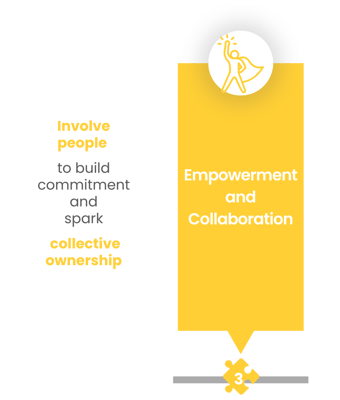
Empowerment and Collaboration
People support what they help create. Empowerment means giving people the tools, trust, and confidence to contribute meaningfully to the change. When employees have ownership and a clear role to play, their commitment and accountability grow. Collaborative, connected teams — who break down silos and share knowledge — build resilience and accelerate progress.
Explore more:
Trust and Psychological Safety
Trust fuels resilience. People will only take risks or speak up if they feel psychologically safe. Leaders should foster honesty, consistency, and respect to build trust. Tools like structured feedback and open dialogue help create environments where accountability and innovation thrive.
Explore more:
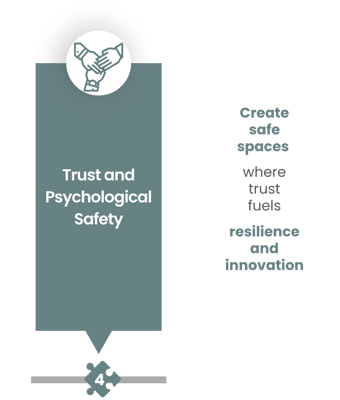
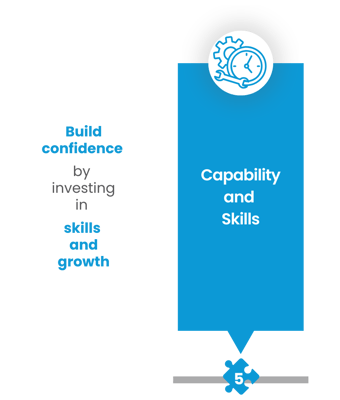
Capability and Skills
Change cannot succeed if people feel unprepared. Whether introducing new technology, shifting strategy, or changing processes, invest in developing skills, confidence, and a growth mindset across the workforce by providing relevant training, mentoring, and opportunities for employees to build mastery. When people feel capable, they are more willing to adapt, experiment, and contribute positively to change efforts.
Explore more:
Performance Systems and Rewards
People follow what is measured, rewarded, and reinforced. When incentives, recognition, and performance expectations align with change goals, new behaviours take hold more reliably. Leaders should make accountability transparent and fair, showing that commitments matter and performance is tied to the success of the change. This consistency motivates teams, rewards progress, and builds trust.
Explore more:
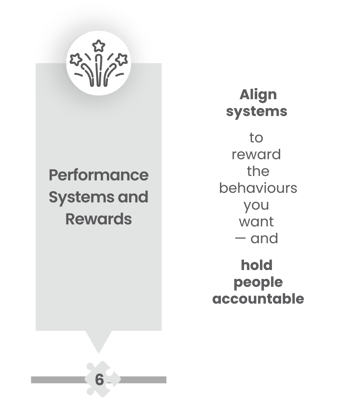
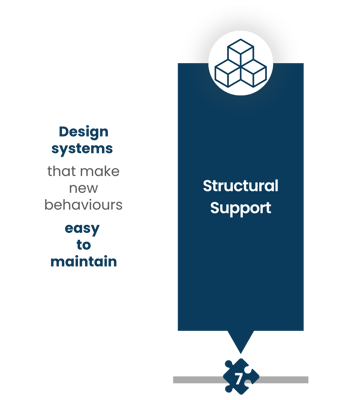
Structural Support
Change doesn’t happen in a vacuum and vision alone won’t deliver outcomes if systems stand in the way. Redesign processes, roles, and governance to support the new ways of working. When employees see that structures support their new behaviours, change feels easier, more credible, and more sustainable.
Explore more:
Sustaining Momentum
Change isn’t finished at launch — you need to embed, reinforce, and celebrate progress so it sticks. Leaders should share stories of success, celebrate quick wins, and keep change visible to maintain enthusiasm and engagement.
Explore more:
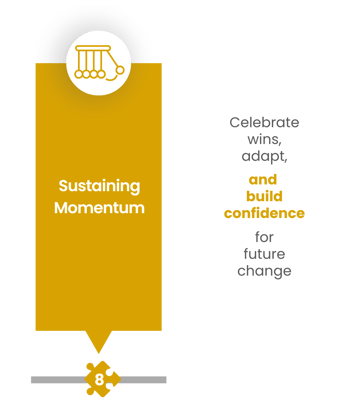
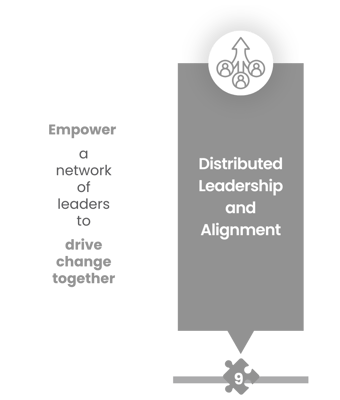
Distributed Leadership and Alignment
Change cannot rest on one person alone. A coalition of leaders — formal and informal — helps spread ownership, amplify the vision, and reinforce priorities. Relying on one champion alone is risky and unsustainable. Multi-level endorsement and buy-in across the organization improves uptake, reduces resistance, and signals that change is everyone’s responsibility. Distributed leadership ensures consistency, enables local solutions, and prevents bottlenecks by empowering leaders at every level to clarify roles, align behaviours, and champion the change.
Explore more:
A Holistic Approach to Executing Large-Scale Healthcare Transformations
Resistance to Change
Fear, fatigue, or confusion
Short-Term Disruptions
Losing sight of priorities
Broken Trust and Credibility
Broken commitments and perceived lack of transparency
Cultural Misalignment
Clashing with legacy values
Leadership Fatigue
Change champions burning out
External Shocks
Economical or geopolitical disruptions
Over-Reliance on Top-Down Control
Missing grass-roots buy-in
Lack of Distributed Leadership
No coalition to carry change forward
Leaders must anticipate these challenges by building trust, aligning incentives, supporting middle managers, and maintaining consistent communications.
Explore more:
Work Better Together: Productive Conflict
From intention to adoption — a simplified approach.
Change leadership is not a one-time event. A structured, repeatable process will keep you focused while minimizing friction:
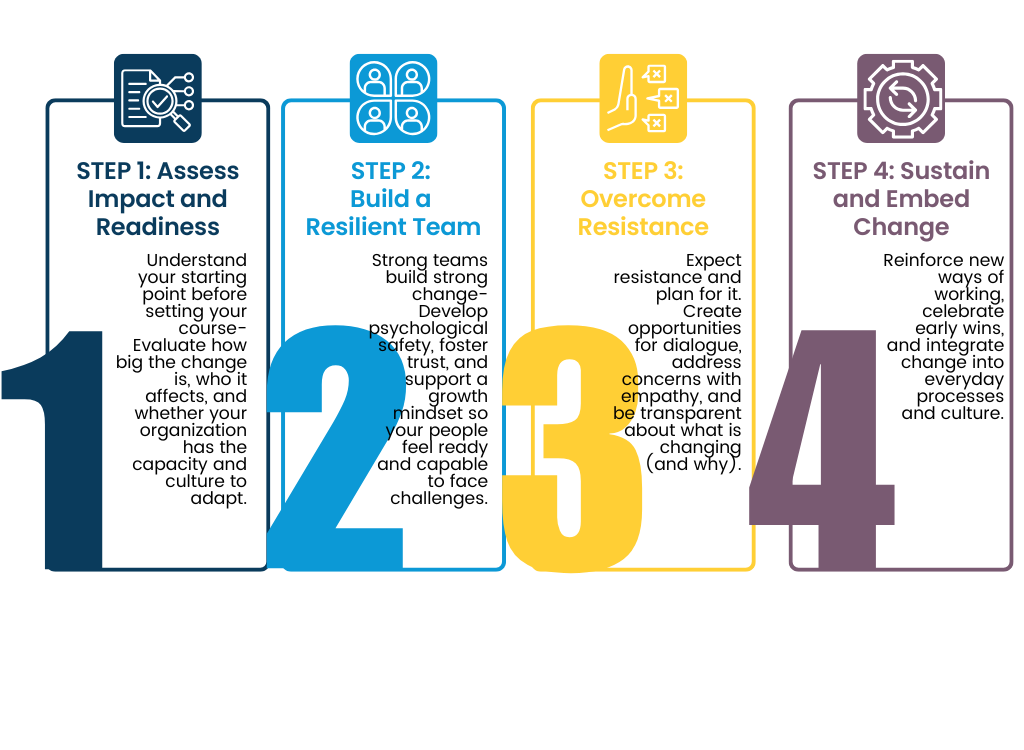
Explore more:
The Great Reset with Liane Davey
Why investing in great change leadership pays off.
Change initiatives often fail when they rely solely on project management methods without strong leadership. While change management focuses on organizing plans, schedules, and risk mitigation, change leadership focuses on inspiring people to embrace, adopt, and sustain change.
A change manager might answer:
“How will we deliver this plan on time?”
A change leader asks:
“How will we help people understand, believe in, and adopt this change?”
The distinction is crucial. Project plans and processes are essential for coordinating tasks, but they cannot spark commitment on their own. It takes a skilled, emotionally intelligent leader to motivate people, build confidence, and reduce fear.
A great change leader will:
✅ Communicate compelling reasons for change
✅ Model trust and confidence
✅ Empower other champions
✅ Sustain momentum through empathy and courage
In short, change leadership goes beyond what needs to happen and focuses on who needs to do it — and how they will feel, act, and grow in the process.
Setting your change leader up for success means giving them:
-
Authority to make decisions
-
Coaching and skills development
-
A clear mandate and support from executives
-
A network of allies to reinforce the message
-
Time and space to build relationships and address concerns
Change is a human journey, and the change leader is the guide. They light the path forward, help others navigate uncertainty, and build the conditions for long-term resilience and confidence.
At the same time, resilient teams amplify these benefits. They share knowledge, adapt to shifting conditions, and help reinforce positive behaviours. Teamwork and trust accelerate adoption and build a culture that can weather future disruptions.
Explore more:
